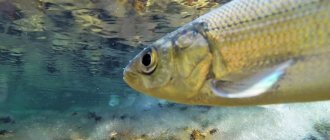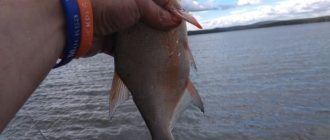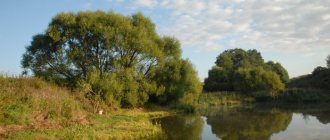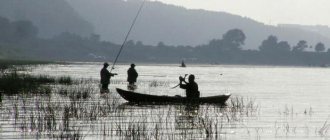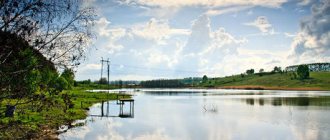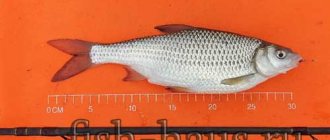Features of fishing in Tenerife
The Canaries attract not only true connoisseurs of active recreation, but also tourists, among whom there are many lovers of various types of fishing. The trophy can be either a large sea predator or a small mackerel, bluefish or yellowtail.
In Canary waters you can catch fish of different sizes.
Fishing options on the island:
- from the shore;
- in the open ocean (trolling and drifting);
- diving.
Fishing requires a license, but in practice tourists do not face any checks when using fishing rods on the shore and often do without a document.
Sports fishing, from the shore and with a harpoon, is subject to licensing.
Types of document:
- For professional fishermen and athletes.
- Fishing using a harpoon.
- Fishing from the shore and boat.
The tour organizers will not only take care of the permit, but will also provide the equipment necessary for underwater hunting and provide instructions. Therefore, it makes sense for tourists to purchase a license only if they are vacationing on their own.
Regardless of where the permit was obtained, the document is valid for 3 years. It can be used throughout the entire archipelago.
Sea fishing
The Atlantic Ocean around Tenerife is rich in various fish, including predatory ones - sharks. For the indigenous inhabitants of the islands, fishing has long been the main activity and remains to this day. And this is understandable, because fishing in Tenerife, like nothing else, will give you the opportunity to feel like a real man, a breadwinner, and to learn what the passion of a hunter is in the fight with big fish. And the fish found off the coast of Tenerife are really huge; you won’t be ashamed to show off such a trophy to your friends and colleagues!
Fishing Features
You can fish on the island both from the shore and in the open Atlantic Ocean. Of course, if you want to catch big fish, you need to go deep. The main types of fish that can be caught fishing off the coast of Tenerife are vieja, dorada, wahoo, eel, tuna, bonito and various types of sharks. A particularly desirable catch for fishermen is the blue marlin (fishing for it is now prohibited).
Fishing in Tenerife is a lot of positive emotions and adrenaline. However, the catch is very dependent on the time of year, because the fish migrate. If you choose to fish in the open ocean, the captain of the boat or yacht will tell you what kind of fish is best to catch now and where to go for this. Two fishing methods commonly used in the open ocean are drifting and trolling.
We work only with the most experienced captains; fishing in Tenerife with us is a guaranteed catch at any time of the year.
Another type of fishing in Tenerife is near the shore. Usually this is how king and Spanish mackerel, yellowtail, bluefish, vieja and other types of small fish are caught. Sometimes you can even catch tuna from the shore. When fishing from the shore, the same methods are used as in the ocean, in addition, you can use a donk.
How to order:
If you decide to order an individual fishing trip and book a trip to the ocean for a certain date, then for this you need to transfer a deposit of 100 euros. This prepayment will guarantee your reservation.
Transfer from the southern resorts to the fishing boat is included in the price.
If you choose a combined tour with other participants, then you need to write to us by email 4-5 days before your opportunity to go out into the ocean. After that, we will notify you about the available opportunity, as well as the required number of participants for fishing.
We accept bank transfers in € - Euro currency, to an account in a Spanish bank, in the Russian VTB bank at the VTB rate (+ 2.5% for the transfer) or by electronic money, such as PayPal, WebMoney - WME. (+ 4 euros)
Phone number for ordering: +(34) 649-418-053 (WhatsApp), email. mail: or contacts
Where can you go fishing?
Fishing from the breakwaters near the beaches is very popular among tourists, where the bite is almost always excellent. But many prefer to retire among the rocky shores. A fishing rod, spinning rod and even a donka are suitable as equipment.
Fishing on beaches and in port areas is prohibited.
On boats they fish in the sea and ocean using sporting methods - trolling and drifting. In the first case, the bait follows the boat at high speed, and in the second, a spoon is used, casting it to a depth of up to 150 m.
Fishing in Tenerife can be combined with a boat trip.
Diving is an exciting part of Tenerife's maritime adventures. When deep-sea hunting there is a chance to catch large specimens of tuna, blue marlin and other rare exotic fish.
Types of fish in Tenerife
Fishing in Tenerife and the Canaries in general is carried out for such types of fish as swordfish, sailfish, white and blue marlin, barracuda, monkfish, blackfish, vieja, dorado, wahoo, sea bass, sharks, and the main trophy and dream of the fisherman is giant tuna. Offshore you can catch Spanish and king mackerel, bluefish, yellowtail and other fish.
Tuna is in great demand in Spain. Salads with this fish, olives and vegetables appear on the table of an ordinary Spaniard every day. And for good reason, because tuna meat is very healthy. The high season for tuna fishing is June, July, August and September. In Gran Canaria and Tenerife there are tuna weighing up to 150 kg, but this is still only half the average weight of blue marlin!
Everyone remembers Hemingway’s famous story “The Old Man and the Sea,” where a large fish fought with a man on the high seas for several days. It was a blue marlin - one of the largest fish in the world. It is considered prestigious among fishermen to catch it. In Tenerife, white and blue marlin are found both offshore and in open water. Hunting for marlin is a very exciting activity, because such fish reach speeds of up to 100 km/h! Once hooked, she fiercely resists, jumps out of the water, and can fight for hours.
The marlin season coincides with the tourist season, from May to September inclusive. Therefore, you may not be able to go on ocean fishing with a good captain during your couple of weeks of vacation; we advise you to book your places in advance.
Best time for fishing
You can relax in Tenerife almost all year round thanks to its unique climatic conditions. From June to October the island is visited by the largest number of tourists. A lot of fishing tours are sold at this time.
Table of favorable times for fishing:
| FISH TYPES | JAN | FEB | IDA | APR | MAY | JUN | ILE | AVG | SEN | OCT | BUT I | DEC |
| Swordfish | + | + | + | + | + | + | ||||||
| Blue marlin | + | + | + | + | + | + | + | + | ||||
| White Marlin | + | + | + | + | ||||||||
| Blackfin tuna | + | + | + | + | + | + | + | |||||
| Barracuda | + | + | + | + | + | + | + | + | + | + | + | + |
| Wahoo | + | + | + | + | + | + | ||||||
| Dorado | + | + | + | + | + | + | + | |||||
| stingray | + | + | + | + | + | + | + | + | + | + | + | + |
| Blue shark | + | + | + | + | + | + | + | + | ||||
| Tope | + | + | + | + | + | + | ||||||
| bluefish | + | + | + | + | + | + | + | + | ||||
| Angler | + | + | + | + | + | + | ||||||
| Triggerfish | + | + | + | + | + | + | + | + |
In the winter season, the water temperature in the ocean is within +19...+20°C, and the surrounding air warms up to +20...+22°C during the day. From January to March you can purchase tours at the lowest prices.
Fishing on the island is available all year round. Only the type of fish that can be caught and the method of catching it depend on the time of year and season. The best time to fish for tuna, barracuda and yellowtail is in January, and for blue marlin in February and March.
Ocean fishing in the Canaries
The Canaries are one of the most picturesque islands in the Atlantic. These islands are of volcanic origin stretching along the African coast for 500 km. The Canary Islands belong to Spain and were discovered in ancient times.
Fishing in the Canary Islands
has worldwide popularity. Due to its geographical location and climatic conditions, the waters of the Canary Islands are home to a huge number of different species of fish and marine animals.
Lovers of sea fishing go to the Canaries for exotic trophies that cannot be obtained in European seas, rivers and lakes. Another advantage of fishing in the Canaries
, is that the best time for fishing coincides with the so-called “dead” season in places with a tropical climate. This allows both amateur fishermen and sperm fishermen to engage in their favorite pastime all year round.
Fishing in the Canaries
fishing for such types of fish as swordfish, sailfish, white and blue marlin, tuna, king mackerel, dorado, etc.
Also on the islands you can fish for giant tuna, which can reach half a ton in weight, and go night fishing for swordfish. For exotic fishing in the Canaries
, yachts, boats, boats are provided, where all the necessary fishing gear is available. However, experienced fishermen who know the peculiarities of ocean fishing in the Canary Islands take the necessary gear and equipment with them.
Ocean fishing in the Canaries
This is not only exotic trophies, but also accommodation in European-level hotels, amazing Canarian cuisine, and the magnificent nature of the Canary archipelago.
Fishing on the island of Tenerife
Tenerife is the largest of the Canary Islands with an area of 2057 km². The capital of the archipelago, Santa Cruz de Tenerife, is located there.
The waters around the island of Tenerife are rich in fish and fishing has been a vital necessity for the indigenous islanders since ancient times. Today, fishing in the Canary Islands
and in Tenerife in particular, one of the most favorite and interesting entertainments for many vacationers.
Fishing on
Tenerife
is excitement, incredible adventures, and the opportunity to compete with big fish. In a word, what most real fishermen strive for.
Fishing in Tenerife is carried out both from various boats in the ocean and from the shore. If the goal of your fishing is a real trophy, then you will have to go to the open ocean to get it; only at depth can you find the desired trophy.
The main fishing destinations in Tenerife
are blue and white marlin, tuna, eel, blue shark, dorado, sailfish. The most valuable trophy of Canarian fishing is considered to be the blue marlin, and to catch this fish you need to have excellent skills and work hard.
The quality and quantity of the catch largely depends on the time of year, as many species of fish often migrate. If your choice falls on ocean fishing away from the shore, the captain of the yacht or boat will explain the situation to you in detail, what kind of fish is preferable to catch at this time and where to go for it. Typically, two fishing methods are used in the open ocean, trolling and drifting.
Fishing from the shore in Tenerife is carried out, as a rule, for Spanish and king mackerel, and some other types of fish of medium size. But from the shore it is also sometimes quite possible to catch tuna or marlin. They fish from the shore with donks, spinning rods and fly fishing.
Fishing in the Canaries in the open ocean
lasts from 4 to 8 hours and all the gear necessary for fishing is provided to the fishing participants.
What is done with the caught fish is at the discretion of the fisherman; some fishermen take pictures with it and release it back. Others take it with them at any restaurant or snack bar and they will prepare it for you without any problems. Fishing in Tenerife
is often combined with boat trips, when the ship goes in search of dolphins, whales, sharks or sea turtles.
Considering these features, fishing in the Canaries
can be an excellent holiday for the whole family.
Fishing from the rocks
Very interesting and exciting fishing in the Canaries from the rocks. Simple equipment is quite suitable for this, which will always provide a good catch.
As a rule, the fewest breaks and snags occur when fishing with a float rod. With the help of heavy sliding floats loaded up to 25 grams, the bait is delivered to the required distance. An olive-type lead sinker of 5-8 grams is attached above a leash with a diameter of 0.4 mm, which should be about 1 m long.
The clear water of the coastal zone makes it possible to determine how deep to install the stopper on a monofilament line with a diameter of 0.3 mm. It is very important that the bait is located at a distance of about 2 meters from the bottom. For those who prefer this kind of fishing in places where there are numerous stones and rocks under water, the tackle sometimes breaks, so it becomes necessary to mount the hook on the leash so that the distance to the sinker is at least 2 meters.
This type of equipment is very effective for catching parrot fish, and the best bait for catching this beautiful and tasty fish is a crab leg. There are plenty of small crabs on the coast. They can even be caught in the rocks. Also good bait are shrimp and cuttlefish, which are abundant in any grocery store. For bait, buy sardines and mix finely chopped sardines with white bread. Prospective points are fed with this puree, which always has a positive effect on fishing results.
Fishing in the Canaries
from the shore
or from the rocks with a spinning rod has many adherents; if you are a fan of spinning rods, it won’t hurt to take a 4-meter fishing rod with you and take narrow spoons and sea wobblers with you in reserve for fishing in the coastal zone. You can always catch something in the ocean both morning and evening.
Fish abundance and species diversity in the waters of the Canary Islands and the coastal zone are very large. In addition to parrot fish, you can catch king mackerel, and bonito and dorado are often caught near the coastal edges.
Mackerel, barbel, dragon fish, barracuda and others are also often caught by coastal fishing. If you are a fan of night fishing, then your catch will be stingrays, snappers, moray eels, squid and octopuses. Rock fishing in the Canary Islands is an unforgettable fishing experience on these fabulous islands. Having been there once, you will want to return there again and again.
Fishing for blue marlin
Blue marlin in the Canary Islands is considered the No. 1 trophy. Once upon a time, the passion for fishing for blue marlin forced the famous writer E. Hemingway to stay in Cuba and live there for a long time. Inspired by fishing for this sea giant, the writer created one of his most famous works, “The Old Man and the Sea.”
Blue marlin is a very prestigious trophy and many fishing enthusiasts go to the Canary Islands just to catch this fish. Fishing in the Canaries
for blue marlin
is one of the most vivid and unforgettable moments in the life of any fisherman who has at least once hunted this giant fish.
Blue marlin is considered the largest fish belonging to the sailfish family. Individual individuals of this species can weigh about 900 kg and have a length of 5 meters. As a rule, females of this species are four times the size of males. The weight of males, with rare exceptions, reaches 160 kg, while the average weight of females is more than 500 kg. The body of the female, together with the 2-nosed spear, often reaches a length of 5 meters. The fish has an elongated upper jaw with which it can stun and kill its prey.
By nature, blue marlin is a passionate hunter. Marlins prefer to hunt in the upper layers of the water; their main prey is mackerel and tuna; their diet also includes crabs, lobsters, sea turtles, squid and octopus. The marlin spends the vast majority of its life away from shore in the open ocean. In search of food, fish can travel vast distances. Fishing for
blue marlin
is carried out both in the open ocean and in the coastal zone.
Thanks to their strong rear and dorsal fins, marlins can reach speeds exceeding 100 km/h and cover enormous distances. Blue marlin is one of the most successful predators in the world in the vast seas and oceans.
The upper part of the marlin's body is dark blue, and the belly is white with a silver tint. On both sides the fish has 15 rows of dim green-blue stripes.
The impressive size of the marlin means that this giant has practically no natural enemies. But young individuals often become prey for sharks, tuna and other underwater predators. Probably, the greatest damage to this species is caused by people in those places where industrial fishing for this fish is carried out, mainly the coast of Southeast Asia.
Fishing in the Canaries
This beauty of the sea is targeted only by amateurs and sports fishermen and does not cause much harm to this fish. Commercial fishing of blue marlin off the coast of the Canary Islands is prohibited.
Fishing for blue marlin
This fish is valued for its ability to fight to the end. Just look at the acrobatic somersaults that a hooked marlin performs above the surface of the water! A fight with this strong and resilient fish can last for hours. Because of its enormous size, stubborn nature and strength, fishermen have always considered this fish to be the best competitor and the most coveted trophy. To get such a trophy you need to have high skill and endurance and a strong character and always remember that the marlin will resist to the end.
Fishing order and prices
Experienced fishermen and companies providing their services on a commercial basis will help you organize a fishing holiday in Tenerife. They will share all the necessary information, provide a boat and gear, and give appropriate recommendations.
The average cost of a fishing tour as of 2021 ranges from 110 to 150 euros per hour per person. The price depends on the duration and type of fishing, the number of vacationers, the vessel used and other factors.
When pre-booking a tour on the official websites of companies involved in this craft, a fee of up to 50% of the amount will be charged.
Fishing in the Canary Islands
Fishing in the Canaries is unthinkable without the participation of local residents. Spaniards, as a rule, are present on the crew of every vessel that goes out to the ocean for sport fishing. Success largely depends on the professionalism of the captain of your ship, so ask in advance how many years he has been in this business and what experience he has. Captains know the lunar cycles, the calendar of "visits" of different fish to the shores of the Canary Islands and also the best time to catch in a particular place around their home islands.
There are no mussels found off the Canary coast; they are brought from Morocco. This is why they are relatively expensive in restaurants, and you won’t be able to catch mussels yourself either. All other “bad creatures”, such as octopus and cuttlefish, are available for all types of fishing in the Canary Islands.
Additional recommendations
People with a weak vestibular system need to approach sea fishing with caution. A physiological feature may be a hindrance when going to sea, especially if the trip is made for the first time.
The cost of the tour can be reduced if you cooperate with other vacationers and bargain with the organizers. Good command of Spanish or the assistance of a Russian-speaking agent will be an advantage in negotiations.
Video
Fishing in Tenerife
In Tenerife you can catch tuna, marlin and other types of fish. The size and quantity depends only on luck and luck.
Reviews from tourists
Egor
39 years old, Kirov
Initially, we decided to relax with my wife in Tenerife, avoiding the services of intermediaries and various restrictions from travel companies. We looked for budget hotels and saved. We found a hotel located literally 50 meters from the ocean. We managed to catch fish and even get a small catch. We rented a boat from the port of Las Americas for 440 euros for 4 hours. The process is unforgettable! First, they catch various small things, and then they use them as bait to lure out large predatory fish.
Elena
26 years old, Vitebsk
I vacationed with friends in June 2021 in Las Americas. Food, location of the hotel - I liked everything. Nearby is the port of Los Cristianos, where the beach is even better and sea fishing costs about 110 euros per person for 4 hours. I was just an observer, watching others catch and enjoying it. Our trophy was a barracuda caught on a spinning rod.
Hooked in Tenerife: secrets of Canarian fishing | Tourism
Tenerife, Gran Canaria, Palma - on these and other islands of the archipelago the weather is almost always good. Even in winter, the air temperature rarely drops below twenty degrees. Therefore, you can swim and fish all year round. True, in January and February the wind interferes; on the island of Fuerteventura it is sometimes so strong that even professional fishermen do not go to sea.
Someone, of course, goes to a restaurant expecting to taste freshly caught fish (which is far from a fact). Others prefer to get it themselves.
Violet-green, sky blue, bright yellow, speckled and striped, the ocean is literally teeming with colorful fish...
By the way, cheap fishing rods for 20 euros break very quickly. Therefore, it’s not worth saving at all. Quite decent, durable folding “telescope” fishing rods that fit in a suitcase can be bought for 40 euros.
If you are aiming to eat your own catch, when choosing a roof over your head, you should pay attention to the presence of a stove. A grill that produces such delicious, crispy octopuses will also come in handy. A house in a fishing village will cost two and a half times more than apartments and peasant houses (Finnish houses), which cost from 40 euros per day, but are often located far from the sea. However, even if you find refuge where the ocean waves reach the very threshold and the road ends, you need to be prepared for the fact that there will be parking nearby for beach and restaurant visitors.
Mullet on shmat buns
Deep sea fishing will cost you money and require physical strength.
A 5-hour tour costs from 70 euros per person. For those who do not lay claim to the giants of the sea - marlin, tuna, barracuda and swordfish, but are content with pike perch or perch - just go to the steep shore - a spur of the volcano that sharply goes into the depths.
Fishing on the beach is not only prohibited, but also useless. Underwater life thrives around the rocks, so sturdy shoes are essential. During the day, sea bream (sea crucian carp) can be caught well from the shore.
Small pieces of shrimp are usually used as bait, which are sold in supermarkets frozen or fresh at a price of 6 euros per kilogram. It is worth taking with you large spirolino floats, as well as small hooks of sizes 6-10.
In the evening the cuttlefish (sepia) comes out to feed. She can hardly resist a fishing innovation - a hooked, three-dimensional imitation shrimp that costs 4 euros apiece and glows when it touches the water. However, you should be prepared for the fact that the catch will cover you with ink by the first day.
As for the mullet, which locals catch directly from the boardwalks using a huge piece of bread, the lightness is deceptive. Mullet is a very cautious fish. And if she doesn’t like something, she immediately spits out the nozzle.
Pay for a piece of paper
| By the way | |
| Local delicacies include parrot fish (vieja in Spanish), which is undoubtedly worth trying. Along with spicy sauces, the fish is served with salted papas arrugadaos potatoes, boiled in sea water. Small bright Canarian tomatoes, red onions and fresh goat cheese are also good. | |
The procedure for obtaining a fishing permit called “La licensencia de pesca maritima” will take very little time, you just need to locate one of the nearest branches of the Department of Agriculture and Fisheries “Consejeria de Agricultura, Ganaderia, Pesca y Alimentacion”, which are available even in small towns .
You must have a copy of your passport with you, otherwise you will also have to search for a copy machine. The receipt received there must be paid at the bank, and then taken to the local administration - Cabildo, which will issue a license.
More precisely, a document certifying its presence. The “crusts” themselves will be ready in three months, but there is absolutely no need to pick them up.
There are three types of licenses:
1. For 28 euros – for professional athletes (hardly useful for tourists). The organizers of deep sea fishing tours take care of everything themselves. Including about equipment, which is impossible to understand and handle without the help of a guide-instructor;
2. For 21 euros – using a harpoon;
3. For 14 euros - a license that allows you to fish both from the shore and from a boat. It is worth purchasing for those who come to relax and go fishing.
The license is valid for three years in all the Canary Islands, regardless of the place of issue.
Reference
Information about the most typical inhabitants of the local deep sea with pictures and names of fish is available on the official website of the government of the Canary Islands.
What is important is that there is a cauldron showing the minimum size of fish (in cm) allowed for fishing.
All. What has not reached it must be released back into the sea, without waiting for the fish to pray in a human voice. Therefore, in addition to fishing rods, don’t forget to take a centimeter with you.
Arguments and Facts Europe No. 17, 2011


